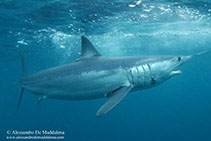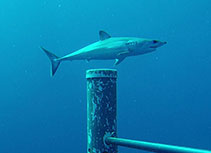Isurus oxyrinchus Rafinesque, 1810
Shortfin mako
把你的觀察加入 Fish Watcher
| Native range | All suitable habitat | Point map | Year 2050 |

|
| This map was computer-generated and has not yet been reviewed. |
| Isurus oxyrinchus AquaMaps Data sources: GBIF OBIS |
Spain country information
Common names:
Atunero, Cane de mare, Diamante
Occurrence: native
Salinity: marine
Abundance: | Ref:
Importance: | Ref:
Aquaculture: | Ref:
Regulations: | Ref:
Uses: no uses
Comments: Found in Galicia (Ref. 86578).
National Checklist:
Country Information: https://www.cia.gov/library/publications/resources/the-world-factbook/geos/sp.html
National Fisheries Authority:
Occurrences: Occurrences Point map
Main Ref: Compagno, L.J.V., 1984
National Database: ICTIMED
Occurrence: native
Salinity: marine
Abundance: | Ref:
Importance: | Ref:
Aquaculture: | Ref:
Regulations: | Ref:
Uses: no uses
Comments: Found in Galicia (Ref. 86578).
National Checklist:
Country Information: https://www.cia.gov/library/publications/resources/the-world-factbook/geos/sp.html
National Fisheries Authority:
Occurrences: Occurrences Point map
Main Ref: Compagno, L.J.V., 1984
National Database: ICTIMED
Common names from other countries
分類 / Names 俗名 | 同種異名 | Catalog of Fishes(屬, 種) | ITIS | CoL | WoRMS | Cloffa
Elasmobranchii 板鰓亞綱 (鯊魚與魟魚) (sharks and rays) > Lamniformes (Mackerel sharks) 鼠鯊目 (Mackerel sharks) > Lamnidae (Mackerel sharks or white shark) 鼠鯊科 (Mackerel sharks or white shark)
Etymology: Isurus: isos (Gr.), equal; oura (Gr.), tail, referring to caudal-fin lobes of I. oxyrinchus being equal in length (except that they are not; the upper is clearly longer) (See ETYFish); oxyrinchus: oxys (Gr.), sharp or pointed; rynchus (L.), snout, referring to its pointed snout (See ETYFish).
More on author: Rafinesque.
Etymology: Isurus: isos (Gr.), equal; oura (Gr.), tail, referring to caudal-fin lobes of I. oxyrinchus being equal in length (except that they are not; the upper is clearly longer) (See ETYFish); oxyrinchus: oxys (Gr.), sharp or pointed; rynchus (L.), snout, referring to its pointed snout (See ETYFish).
More on author: Rafinesque.
Environment: milieu / climate zone / depth range / distribution range 生態學
海洋; 海洋洄游的 (Ref. 51243); 深度上下限 0 - 888 m (Ref. 106604), usually 100 - 150 m (Ref. 36731). 亞熱帶的; 16°C - ? (Ref. 9988); 65°N - 54°S, 180°W - 180°E
分布 國家 | FAO區域 | 生態系 | 發現紀錄 | Point map | 簡介 | Faunafri
Cosmopolitan in temperate and tropical seas (Ref. 6871, 11230). Western Atlantic: Gulf of Maine to southern Brazil and Argentina (Ref. 58839), including the Gulf of Mexico and Caribbean. Eastern Atlantic: Norway to South Africa, including the Mediterranean. Indo-Pacific: East Africa to Hawaii, north to Primorskiy Kray (Russian Federation), south to Australia and New Zealand. Eastern Pacific: south of Aleutian Islands and from southern California, USA to Chile.
全球分佈於溫帶與熱帶的海洋。 (參考文獻 6871,11230) 西大西洋: 緬因灣到巴西南部與阿根廷 (參考文獻 58839), 包括墨西哥灣與加勒比海。 東大西洋: 挪威到南非, 包括地中海。 印度-太平洋: 東非到夏威夷, 北至 Primorskiy Kray(俄羅斯聯邦), 南至澳洲與紐西蘭。 東太平洋: 阿留申群島南方與從美國的南加州到智利。
全球分佈於溫帶與熱帶的海洋。 (參考文獻 6871,11230) 西大西洋: 緬因灣到巴西南部與阿根廷 (參考文獻 58839), 包括墨西哥灣與加勒比海。 東大西洋: 挪威到南非, 包括地中海。 印度-太平洋: 東非到夏威夷, 北至 Primorskiy Kray(俄羅斯聯邦), 南至澳洲與紐西蘭。 東太平洋: 阿留申群島南方與從美國的南加州到智利。
Length at first maturity / 大小 / 重量 / 年齡
Maturity: Lm 278.3, range 275 - 285 cm
Max length : 445 cm TL 雄魚/尚未辨別雌雄; (Ref. 106604); common length : 270 cm TL 雄魚/尚未辨別雌雄; (Ref. 5217); 最大體重: 505.8 kg (Ref. 4699); 最大年齡: 32 年 (Ref. 86588)
Max length : 445 cm TL 雄魚/尚未辨別雌雄; (Ref. 106604); common length : 270 cm TL 雄魚/尚未辨別雌雄; (Ref. 5217); 最大體重: 505.8 kg (Ref. 4699); 最大年齡: 32 年 (Ref. 86588)
簡短描述 檢索表 | 型態特徵 | 形態測量圖
背棘 (總數) : 0; 臀棘: 0. A large, spindle-shaped shark with large black eyes, a sharp snout, and large, narrow, hooked teeth with smooth edges (Ref. 5578). Caudal fin lunate, lower lobe strongly developed (Ref. 13574). Dark blue above, white below (Ref. 6581). Tiny second dorsal and anal fins (Ref. 26938).
大, 紡錘形的鯊魚有大的黑色眼,一個銳利的吻, 與大的﹐狹窄的﹐和鉤狀的牙齒有平滑的邊緣.(參考文獻 5578) 尾鰭新月狀的, 下葉發育明顯的.(參考文獻 13574) 背面深藍色的, 腹面白色的.(參考文獻 6581) 極小的第二背鰭與臀鰭.(參考文獻 26938)
大, 紡錘形的鯊魚有大的黑色眼,一個銳利的吻, 與大的﹐狹窄的﹐和鉤狀的牙齒有平滑的邊緣.(參考文獻 5578) 尾鰭新月狀的, 下葉發育明顯的.(參考文獻 13574) 背面深藍色的, 腹面白色的.(參考文獻 6581) 極小的第二背鰭與臀鰭.(參考文獻 26938)
Oceanic, but sometimes found close inshore (Ref. 6871, 11230, 58302). Usually in surface waters (Ref. 30573), down to about 150 m (Ref. 26938, 11230). Coastal, epipelagic at 1->500 m (Ref. 58302). Isotope analysis has shown that shortfin mako is the highest level fish predator in oceanic waters off eastern Australia (Ref. 86961). Adults feed on bony fishes, other sharks (Ref. 5578), cephalopods; larger individuals may feed on larger prey such as billfish and small cetaceans (Ref. 6871, 58048). Ovoviviparous, embryos feeding on yolk sac and other ova produced by the mother (Ref. 43278, 50449). With 4-16 young of about 60-70 cm long (Ref. 35388, 26346). Gestation period lasts 15-18 months, spawning cycle is every 3 years. Some authors (Refs. 1661, 28081, 31395) have erroneously assumed that two age rings are deposited per year by this species, thus underestimating longevity, age at maturity, and resilience . These data have been removed and replaced by recent, verified estimates (Refs. 86586, 86587, 86588). Tagging in New Zealand indicates seasonal migrations (Ref. 26346). The presence of genetic differentiation in mitochondrial DNA across global populations (Ref. 36416) suggests dispersal may be male-biased, and that females may have natal site-fidelity. Shortfin mako has been shown to have a marked sexually segregated population structure (Ref. 86954). Shortfin mako is probably the fastest of all sharks and can leap out of the water when hooked (Ref. 6871). Potentially dangerous and responsible for unprovoked attacks on swimmers and boats (Ref. 13574). Utilized fresh, dried or salted, smoked and frozen; eaten broiled and baked (Ref. 9988). Valued for its fine quality meat as well as its fins and skin (Ref. 247). Oil is extracted for vitamins and fins for shark-fin soup (Ref. 13574). Jaws and teeth are also sold as ornaments and trophies (Ref. 9988). by Kabasakal & de Maddalena, 2011 reported a historical record of a larger specimen, caught in the Mediterranean Sea off Turkey, about 585 cm (TL estimated from photographs) (Ref. 106604). Maximum depth from Ref. 125614.
大洋性的, 但是有時發現近岸.(參考文獻 6871,11230,58302) 通常在水表面 (參考文獻 30573), 向下至大約 150 公尺.(參考文獻 26938,11230) 海岸的, 表層帶在單一 >500 公尺的.(參考文獻 58302) 吃硬骨魚類,其他的鯊魚 (參考文獻 5578) ,頭足類動物; 較大的個體可能吃較大的獵物例如青旗魚與小的鯨類。 (參考文獻 6871) 卵胎生的, 胚胎吃產生於母親的卵黃囊與其他的卵.(參考文獻 50449) 多達 18 幼魚在一胎.(參考文獻 26346) 在紐西蘭附以籤條指出季節性的迴游。 (參考文獻 26346) 可能所有鯊魚的最快速的而且能從水中跳出來當鉤住.(參考文獻 6871) 可能危險而的原因未受刺激的攻擊游泳者與船.(參考文獻 13574) 生鮮使用, 乾燥或鹽醃, 煙燻與冷凍的; 吃火烤.而且燒烤..(參考文獻 9988) 重要的是它的細品質肉.以及它的鰭與皮膚.(參考文獻 247) 油被吸取用於維他命與鰭用於魚翅湯。 (參考文獻 13574) 顎與齒也被賣作裝飾品與獎座。 (參考文獻 9988) 對 4-16個幼魚生產, 60-70 公分長.(參考文獻 35388)
大洋性的, 但是有時發現近岸.(參考文獻 6871,11230,58302) 通常在水表面 (參考文獻 30573), 向下至大約 150 公尺.(參考文獻 26938,11230) 海岸的, 表層帶在單一 >500 公尺的.(參考文獻 58302) 吃硬骨魚類,其他的鯊魚 (參考文獻 5578) ,頭足類動物; 較大的個體可能吃較大的獵物例如青旗魚與小的鯨類。 (參考文獻 6871) 卵胎生的, 胚胎吃產生於母親的卵黃囊與其他的卵.(參考文獻 50449) 多達 18 幼魚在一胎.(參考文獻 26346) 在紐西蘭附以籤條指出季節性的迴游。 (參考文獻 26346) 可能所有鯊魚的最快速的而且能從水中跳出來當鉤住.(參考文獻 6871) 可能危險而的原因未受刺激的攻擊游泳者與船.(參考文獻 13574) 生鮮使用, 乾燥或鹽醃, 煙燻與冷凍的; 吃火烤.而且燒烤..(參考文獻 9988) 重要的是它的細品質肉.以及它的鰭與皮膚.(參考文獻 247) 油被吸取用於維他命與鰭用於魚翅湯。 (參考文獻 13574) 顎與齒也被賣作裝飾品與獎座。 (參考文獻 9988) 對 4-16個幼魚生產, 60-70 公分長.(參考文獻 35388)
Life cycle and mating behavior 成熟度 | 繁殖 | 產卵場 | 卵 | 孕卵數 | 仔魚
Exhibit ovoviparity (aplacental viviparity), with embryos feeding on other ova produced by the mother (oophagy) after the yolk sac is absorbed (Ref. 50449). With up to 18 young in a litter (Ref. 26346). Gives birth to litters of 4-25 (usually 10-18) pups after a gestation period of 15-18 months; reproduces every 3 years (Ref.58048). Size at birth between 60 and 70 cm (Ref. 247). Distinct pairing with embrace (Ref. 205).全球分佈於溫帶與熱帶的海洋。 (參考文獻 6871,11230) 西大西洋: 緬因灣到巴西南部與阿根廷 (參考文獻 58839), 包括墨西哥灣與加勒比海。 東大西洋: 挪威到南非, 包括地中海。 印度-太平洋: 東非到夏威夷, 北至 Primorskiy Kray(俄羅斯聯邦), 南至澳洲與紐西蘭。 東太平洋: 阿留申群島南方與從美國的南加州到智利。
主要參考資料
Upload your references | 參考文獻 | 合作者 : Compagno, Leonard J.V. | 合作者
Compagno, L.J.V., 1984. FAO Species Catalogue. Vol. 4. Sharks of the world. An annotated and illustrated catalogue of shark species known to date. Part 1 - Hexanchiformes to Lamniformes. FAO Fish. Synop. 125(4/1):1-249. Rome, FAO. (Ref. 247)
人類使用
漁業: 低經濟; 游釣魚種: 是的
FAO(漁業: 產生, 魚種描繪; publication : search) | FIRMS (Stock assessments) | FishSource | 周邊海洋
更多資訊
Population dynamics
成長參數
Max. ages / sizes
Length-weight rel.
Length-length rel.
長度-頻率
Mass conversion
入添量
豐度
成長參數
Max. ages / sizes
Length-weight rel.
Length-length rel.
長度-頻率
Mass conversion
入添量
豐度
Physiology
Body composition
Nutrients
耗氧量
游泳類型
游泳速度
Visual pigments
Fish sound
Diseases & Parasites
Toxicity (LC50s)
Body composition
Nutrients
耗氧量
游泳類型
游泳速度
Visual pigments
Fish sound
Diseases & Parasites
Toxicity (LC50s)
Genetics
遺傳學
Heterozygosity
遺傳率
遺傳學
Heterozygosity
遺傳率
工具
E-book | 野外調查 | 檢索表 | 長度- 頻率 Wizard | 生活- 歷史的工具 | 分布圖 | Classification Tree
| Catch-MSY |
特別的報告
下載 XML
網路資源
Aquatic Commons | BHL | Cloffa | BOLDSystems | Websites from users | 檢查 FishWatcher | CISTI | Catalog of Fishes(屬, 種) | DiscoverLife | ECOTOX | Faunafri | Fishtrace | GenBank(基因組, 核甘) | GloBI | GOBASE | GoMexSI (interaction data) | | Google Books | Google Scholar | Google | IGFA World Record | MitoFish | 國家資料庫 | Otolith Atlas of Taiwan Fishes | PubMed | Reef Life Survey | 魚類百科全書 | Scirus | SeaLifeBase | 樹狀分類階層 | Wikipedia(去, 搜尋) | World Records Freshwater Fishing | Zoobank | 動物學的記錄
Estimates based on models
Preferred temperature (Ref. 115969): 9.7 - 24.4, mean 17.4 (based on 598 cells).
Phylogenetic diversity index (Ref. 82804): PD50 = 0.7813 [Uniqueness, from 0.5 = low to 2.0 = high].
Bayesian length-weight: a=0.00646 (0.00388 - 0.01075), b=3.03 (2.88 - 3.18), in cm Total Length, based on LWR estimates for this species & (Sub)family-body (Ref. 93245).
營養階層 (Ref. 69278): 4.5 ±0.0 se; based on diet studies.
回復力 (Ref. 120179): 低的, 最小族群倍增時間4.5 - 14 年 (rm=0.051; tm=8-20; tmax=32; Fec=4).
Prior r = 0.14, 95% CL = 0.09 - 0.21, Based on 3 full stock assessments.
Fishing Vulnerability (Ref. 59153): Very high vulnerability (79 of 100).
Climate Vulnerability (Ref. 125649): High vulnerability (62 of 100).







